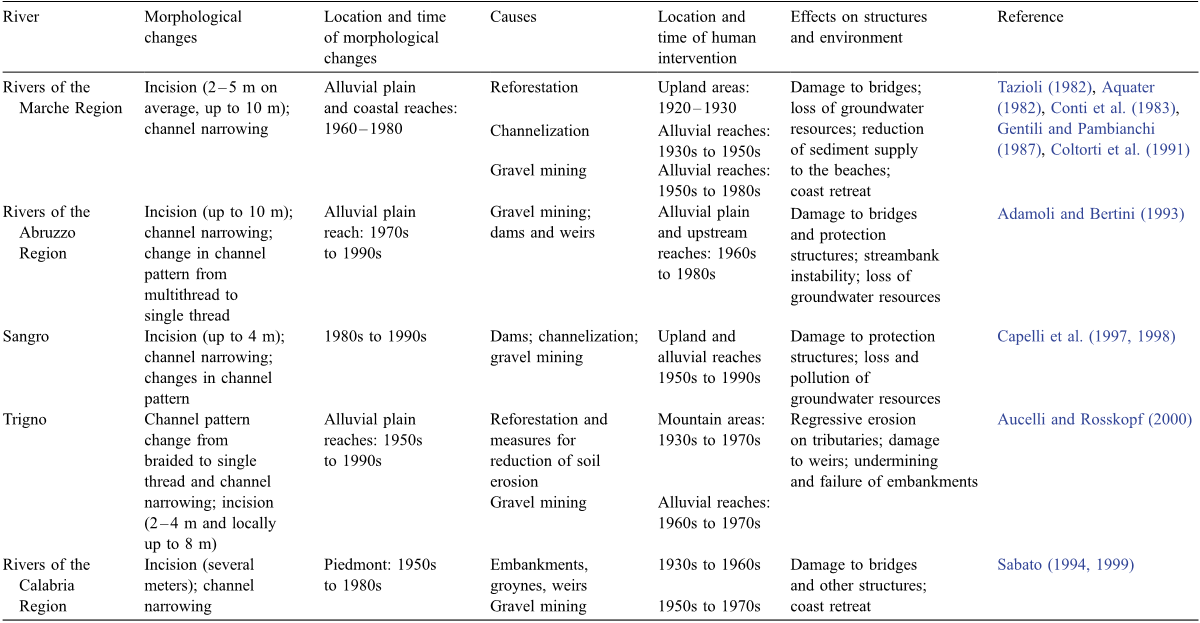Morphological response to river engineering and management in alluvial channels in Italy
Nicola Surian,Massimo Rinaldi +1 more
Reads0
Chats0
TLDR
In this article, the authors reviewed all existing published studies and available data, and aimed to reconstruct a general outline of the main channel adjustments that have occurred in Italian rivers during the past 100 years.About:
This article is published in Geomorphology.The article was published on 2003-03-01 and is currently open access. It has received 580 citations till now. The article focuses on the topics: Channel pattern & Fluvial.read more
Figures

Fig. 5. Trends of average channel width in the braided reach of the Piave River (the reach is 115 km long). Channel width was measured along 94 transects on historical maps and aerial photographs (modified from Surian, in press). 
Fig. 3. Channel narrowing along the Brenta River: (A) topographic map (I.G.M.) of 1887; (B) aerial photograph of 1999. Besides narrowing, decrease in intensity of braiding, increase in channel sinuosity and change in channel pattern (from braided to wandering) have taken place during the last century. 
Fig. 4. Trends of bed-level adjustments. (A) Po River: minimum annual river stage at the gauging station of Cremona (modified from Lamberti and Schippa, 1994). (B) Arno River in the Lower Valdarno reach: changes in bed bottom elevation obtained from longitudinal profiles and cross sections of different years (modified from Rinaldi and Simon, 1998). Horizontal hatched line: trend of stable (dynamic equilibrium) conditions before incision; continuous curves: fitting exponential decay functions. 
Table 3 (continued ) 
Table 2 Recent channel adjustments in Italian rivers and relative causes and effects 
Fig. 2. Channel incision along the Arno River in the Lower Valdarno–Pisa Plain reach. (A) Example of typical change in cross section, with limited bed lowering from 1936 to 1954, and intense incision from 1954 to 1978. Total bed level lowering from 1844 to 1978 was 6.3 m. (B) Bridge 2 km upstream of the previous section, with exposed piles due to the incision.
Citations
More filters
Hydro-morphological processes through permeable sediment traps at mountain rivers
TL;DR: In this paper, a new concept of permeable sediment traps, which are permeable for bed load transport up to floods which are frequent and not yet dangerous for the downstream reach, but which retain safely sediment for hazardous floods, is presented.
Journal ArticleDOI
Use of aerial multispectral images for spatial analysis of flooded riverbed-alluvial plain systems: the case study of the Paglia River (central Italy)
Raffaella Brigante,Corrado Cencetti,Pierluigi De Rosa,Andrea Fredduzzi,Fabio Radicioni,Aurelio Stoppini +5 more
TL;DR: In this paper, a technique of remote sensing in fluvial geomorphology is introduced, which can also be applied to river systems, also under particular conditions, like after flood events.
Journal ArticleDOI
Channels in the Making – An Appraisal of Channel Evolution Models
TL;DR: In this paper, the authors survey the historical development of channel evolution models, how they function, and what types of CEMs are best suited for different geomorphic settings, and present the emergence of multi-pathway CEM models, which have been used to capture the evolutionary trajectories in complex fluvial systems.
Journal ArticleDOI
A clustering classification of catchment anthropogenic modification and relationships with floods.
TL;DR: The research introduces a methodological approach to classify the degree of anthropogenic modifications at catchment scale using clustering techniques applied to 508 catchments in a high-risk flooding sector of the Mediterranean region and shows that three classes clustering is the more appropriate from a computational point of view.
Journal ArticleDOI
Flushing sediment from reservoirs triggers forestation in the downstream reaches
TL;DR: In this article, it was assumed that sediment release from a reservoir would trigger forestation and change the spatial pattern of tree recruitment in the downstream of the Kurobe River by observation on a downstream sandbar.
References
More filters
Journal ArticleDOI
PROFILE: Hungry Water: Effects of Dams and Gravel Mining on River Channels
TL;DR: Management of sand and gravel in rivers must be done on a regional basis, restoring the continuity of sediment transport where possible and encouraging alternatives to river-derived aggregate sources.
OtherDOI
Downstream effects of dams on alluvial rivers.
G.P. Williams,M.G. Wolman +1 more
TL;DR: In this paper, the authors describe changes in mean channel-bed elevation, channel width, bed-material sizes, vegetation, water discharges, and sediment loads downstream from 21 dams constructed on alluvial rivers.
Journal ArticleDOI
A model of channel response in disturbed alluvial channels
TL;DR: In this article, the adjustment of channel geometry and phases of channel evolution are characterized by six process-oriented stages of morphologic development, premodified, constructed, degradation, threshold, aggradation, and restabilization.
Journal ArticleDOI
Riparian vegetation and island formation along the gravel‐bed Fiume Tagliamento, Italy
Angela M. Gurnell,Geoffrey E. Petts,David M. Hannah,Barnaby P.G. Smith,Peter J. Edwards,Johannes Kollmann,James V. Ward,Klement Tockner +7 more
TL;DR: In this paper, a conceptual model of island development is proposed which integrates the interactions between large woody debris and vegetation, geomorphic features, sediment calibre and hydrological regime.
Related Papers (5)
Causes of 20th century channel narrowing in mountain and piedmont rivers of southeastern France
Frédéric Liébault,Hervé Piégay +1 more